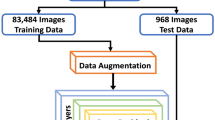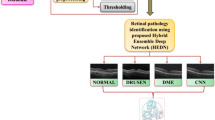Abstract
Today, the analysis of medical images has gained importance with the advancement of technology. The optical coherence tomography (OCT) imaging technique, one of the medical imaging methods, is prevalent in retinal imaging. With the analysis of retinal images, some age-related and diabetes-related diseases can be detected in the macular layer, which is essential for the human visual system. In the study, standard retinal images and retinal images of choroidal neovascularization (CMV), drusen, diabetic macular edema (DME) diseases from an open-access website (kaggle) were used as a dataset. The architecture that gives the highest accuracy in disease diagnosis is proposed by applying deep learning methods ResNet-152, HitNet, Efficient-B0 and Efficient-B7 on the data set. Among these three architectures, the ResNet-152 architecture gave the most successful result with an accuracy rate of 99.17%. In addition, an ensemble model was created under the name of RDV-Net in the study. RDV-Net; It showed a high classification success rate of 99.78% on the Mnist dataset and 99.12% on the Cifar-10 dataset. When RDV-Net was applied to the data set used in the study, 99.59% test success was achieved.
Access this chapter
Tax calculation will be finalised at checkout
Purchases are for personal use only
Similar content being viewed by others
References
He X, Fang L, Rabbani H, Chen X, Liu Z (2020) Retinal optical coherence tomography image classification with label smoothing generative adversarial network. Neurocomputing
Das V, Dandapat S, Bora PK (2019) Multi-scale deep feature fusion for automated classification of macular pathologies from OCT images. Biomed Sig Process Control 54:101605
Toptan M, Satici A, Sağlik A (2018) Yaşa Bağli Maküla Dejenerasyonunun Yaş Tipinde Intravitreal Ranibizumab Enjeksiyonun Etkinliğinin Araştirilmasi. J Harran Univ Med Fac 15(3)
Erçalik Y, Türkseven Kumral E, İmamoğlu S (2018) Ranibizumab Tedavisine Yetersiz Yanit Veren Diyabetik Makula Ödeminde Aflibercept Tedavisi Erken Dönem Sonuçlar. Retina-Vitreus/J Retina-Vitreous 27(1)
Huang D, Swanson EA, Lin CP, Schuman JS, Stinson WG, Chang W, Hee MR, Flotte T, Gregory K, Puliafito CA et al (1991) Optical coherence tomography. Science 254:1178–1181
Mumcuoglu T, Erdurman C, Durukan AH (2008) Optik Koherens Tomografi Prensipleri Ve Uygulamadaki Yenilikler. Turk J Ophthalmol 38:168–175
Dikkaya F, Özkök A, Delil Ş (2018) Parkinson Hastaliğinda Retina Sinir Lifi Tabakasi Ve Makula Kalinliğinin Değerlendirilmesi. Dicle Tip Dergisi 45(3):335–340
Fang L, Jin Y, Huang L, Guo S, Zhao G, Chen X (2019) Iterative fusion convolutional neural networks for classification of optical coherence tomography images. J Vis Commun Image Represent 59:327–333
Alsaih K, Lemaitre G, Rastgoo M, Massich J, Sidibé D, Meriaudeau F (2017) Machine learning techniques for diabetic macular edema (DME) classification on SD-OCT images. Biomed Eng Online 16(1):68
Cavaliere C, Vilades E, Alonso-Rodríguez M, Rodrigo MJ, Pablo LE, Miguel JM, Garcia-Martin E et al (2019)Computer-aided diagnosis of multiple sclerosis using a support vector machine and optical coherence tomography features.Sensors19(23):5323
Hussain MA, Bhuiyan AD, Luu C, Theodore Smith RH, Guymer R, Ishikawa H, Ramamohanarao K et al (2018) Classification of healthy and diseased retina using SD-OCT imaging and random forest algorithm.PLoS ONE13(6):E0198281
Rasti R, Rabbani H, Mehridehnavi A, Hajizadeh F (2017) Macular OCT classification using a multi-scale convolutional neural network ensemble. IEEE Trans Med Imaging 37(4):1024–1034
Retinal OCT images (optical coherence tomography). Erişim: https://www.Kaggle.Com/Paultimothymooney/Kermany2018. Son Erişim Tarihi: 31 July 2020
Detect retina damage from OCT images, Erişim: https://www.Kaggle.Com/Paultimothymooney/Detect-Retina-Damage-From-Oct-Images. Son Erişim Tarihi: 21 Oct 2020
He K, Zhang X, Ren S, Sun J (2016) Deep residual learning for image recognition. In: Proceedings of the IEEE conference on computer vision and pattern recognition, pp 770–778
Deliege A, Cioppa A, Van Droogenbroeck M (2018) Hitnet: a neural network with capsules embedded in a hit-or-miss layer, extended with hybrid data augmentation and ghost capsules. Arxiv Preprint Arxiv:1806.06519
Beşer F, Kizrak MA, Bolat B, Yildirim T (May 2018) Recognition of sign language using capsule networks. In: 2018 26th signal processing and communications applications conference (SIU). IEEE, pp 1–4
Tan M, Le QV (2019) Efficientnet: rethinking model scaling for convolutional neural networks. Arxiv Preprint Arxiv:1905.11946
Huang G, Liu Z, Van Der Maaten L, Weinberger KQ (2017) Densely connected convolutional networks. In: Proceedings of the IEEE conference on computer vision and pattern recognition, pp 4700–4708
Amit Kamran S, Saha S, Shihab Sabbir A, Tavakkoli A (2019) Optic-Net: a novel convolutional neural network for diagnosis of retinal diseases from optical tomography images. Arxiv, Arxiv-1910
Li F, Chen H, Liu Z, Zhang X, Wu Z (2019) Fully automated detection of retinal disorders by image-based deep learning. Graefe’s Arch Clin Exp Ophthalmol 257(3):495–505
Kharisudin I, Az-Zahra MF, Winarti ER, Waluya SB (June 2020) Deep convolutional neural networks for the detection of macular diseases from optical coherence tomography images. J Phys Conf Ser 1567(2):022076 (IOP Publishing)
Li F, Chen H, Liu Z, Zhang XD, Jiang MS, Wu ZZ, Zhou KQ (2019) Deep learning-based automated detection of retinal diseases using optical coherence tomography images. Biomed Opt Express 10(12):6204–6226
Islam KT, Wijewickrema S, O’Leary S (June 2019) Identifying diabetic retinopathy from OCT images using deep transfer learning with artificial neural networks. In: 2019 IEEE 32nd international symposium on computer-based medical systems (CBMS). IEEE, pp 281–286
Alqudah AM (2020) AOCT-NET: a convolutional network automated classification of multiclass retinal diseases using spectral-domain optical coherence tomography images. Med Biol Eng Comput 58(1):41–53
Sertkaya ME, Ergen B, Togacar M (June 2019) Diagnosis of eye retinal diseases based on convolutional neural networks using optical coherence images. In: 2019 23rd international conference electronics. IEEE, pp 1–5
Tasnim N, Hasan M, Islam I (2019) Comparisonal study of deep learning approaches on retinal OCT image. Arxiv Preprint Arxiv:1912.07783
Tsuji T, Hirose Y, Fujimori K, Hirose T, Oyama A, Saikawa Y, Kotoku JI et al (2020) Classification of optical coherence tomography images using a capsule network.BMC Ophthalmol20(1):1–9
Acknowledgements
We want to thank everyone who made the Retinal OCT Images (optical coherence tomography) open-source data used in the study available on the website (kaggle).
Author information
Authors and Affiliations
Corresponding author
Rights and permissions
Copyright information
© 2023 The Author(s), under exclusive license to Springer Nature Switzerland AG
About this paper
Cite this paper
Aksoy, B., Ateş, F., Salman, O.K.M., Armağan, H., Soyaltin, E., Özcan, E. (2023). An Example Application for Early Diagnosis of Retinal Diseases Using Deep Learning Methods. In: Smart Applications with Advanced Machine Learning and Human-Centred Problem Design. ICAIAME 2021. Engineering Cyber-Physical Systems and Critical Infrastructures, vol 1. Springer, Cham. https://doi.org/10.1007/978-3-031-09753-9_2
Download citation
DOI: https://doi.org/10.1007/978-3-031-09753-9_2
Published:
Publisher Name: Springer, Cham
Print ISBN: 978-3-031-09752-2
Online ISBN: 978-3-031-09753-9
eBook Packages: Intelligent Technologies and RoboticsIntelligent Technologies and Robotics (R0)




